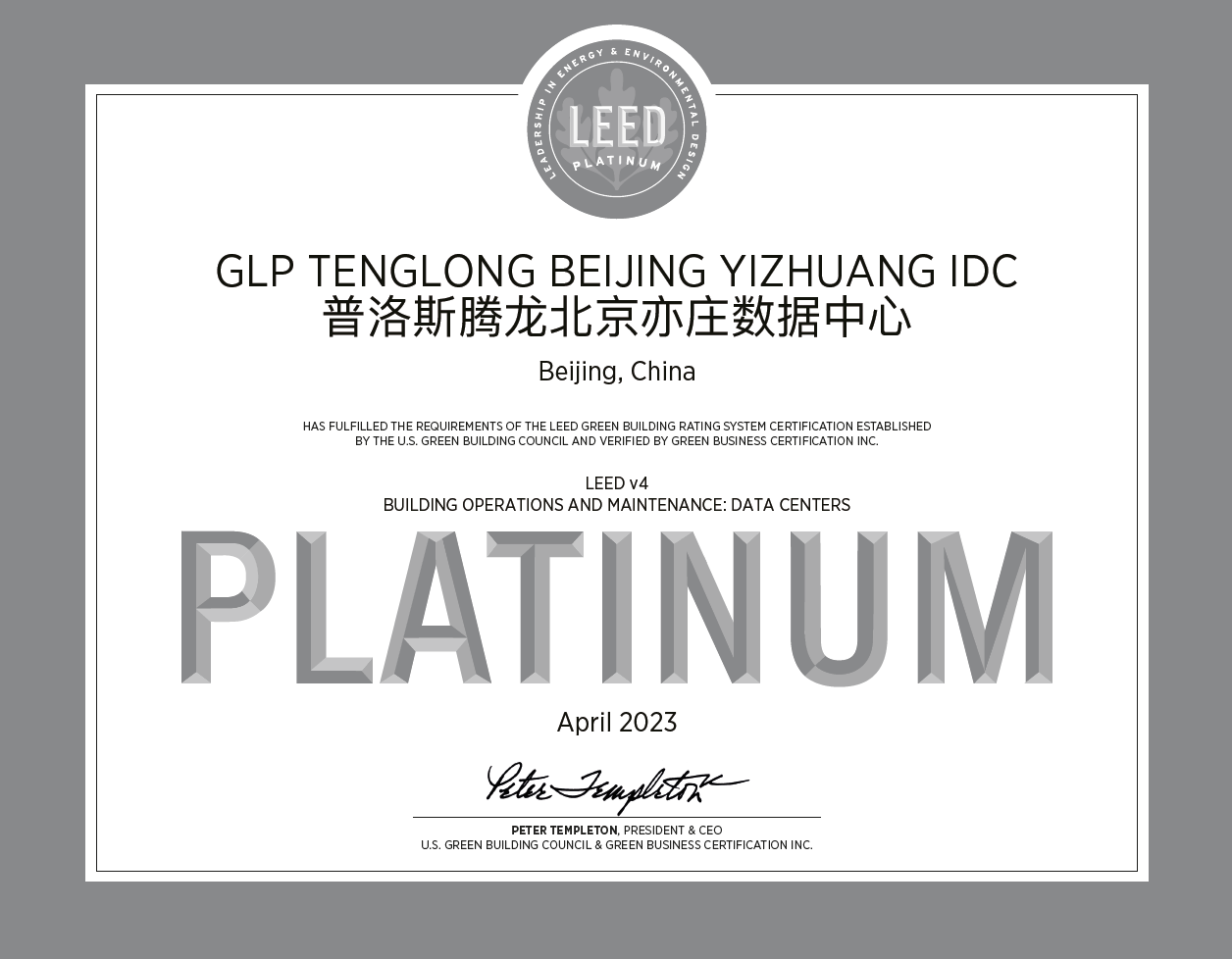GLP data centers are designed, built and operated in accordance with GLP’s ESG principles. In China, GLP is one of the largest independent data center operators with assets that will deliver over 1,400 MW of IT capacity. Our full-service data center platform is led by a best-in-class team of over 700 professionals with deep domain knowledge across IT, utilities and mobile communications companies. GLP has committed to ensuring that 100% of its new data center projects in China comply with GB-A/T3 1 standards and ODCC2 2 certification.
Case Study: GLP Beijing Yizhuang Data Center (“GLP Beijing Yizhuang DC”)
GLP Beijing Yizhuang DC is a tier 3 cloud data center with a total GFA of 18,230 sqm and 17.4 MW power capacity. It is located in greater Beijing which is one of the key data center hubs in China. Sustainability was factored in all stages of the asset lifecycle from design to operations and management.

GLP Beijing Yizhuang DC is designed with reflective roofs to reflect solar radiation, reducing the heat island effect and energy required to maintain overall building temperature. The data center is designed to utilize high voltage direct current (HVDC) power supply which is more energy efficient and cost effective than traditional alternating current (AC) power distribution. It also uses a chilled water cooling system which requires less energy than conventional air-cooled chillers.
All server rooms are installed with intelligent lighting systems which are configured to prevent energy wastage and the data center is equipped with sustainable lighting fixtures which are 100% mercury free. These initiatives earned GLP Beijing Yizhuang DC a 96 out of 100 score in its Energy Star evaluation by the U.S. Environmental Protection Agency (EPA). Water usage was reduced by approximately 27% through water-saving appliances and the upgrading of faucets and pipelines, and approximately 62% of the data center’s daily operation supplies are sustainably procured.
In addition to its advanced environmental design features, GLP also enhanced the sustainability of the data center’s day to day operations. GLP Beijing Yizhuang DC is equipped with GLP DC Base, a proprietary multi-data center smart operation and management system which utilizes centralized control model, digital twin, and artificial intelligence technologies to monitor and manage performance parameters such as temperature, humidity, water and air quality to optimize energy efficiency. Through these measures, GLP Beijing Yizhuang DC was able to save approximately 260 tonnes of carbon emissions in 2022.

As recognition of its sustainable performance, GLP Beijing Yizhuang DC received Leadership in Energy and Environmental Design (LEED) v4 Platinum certification for building operations and maintenance. This is the highest level of certification by LEED, the most widely used green building rating system in the world, and GLP Beijing Yizhuang DC is one of the few data center infrastructure projects in China to achieve this level of certification.
1 GuoBiao (GB) standards are the highest classification of national standards with specifications issued by China for various products and services. A Tier 3 (T3) data center has multiple paths for power and cooling and systems in place to update and maintain it without taking it offline.
2 Open Data Center Committee (ODCC) is formed by key data center industry players with an aim to create an open data center platfor in China and promote the development, acceleration and standardization of the industry.

The Hong Kong Trade Development Council (HKTDC) and Link Asset Management Limited (Link) released a survey study, “Hong Kong Green Capabilities in Real Estate Development and Property Management: RCEP Opportunities”, which highlights seven distinct advantages of Hong Kong in the field of green buildings.
The report also underscores green building challenges across the Regional Comprehensive Economic Partnership (RCEP) countries, with which Hong Kong can strengthen collaboration in four major areas to expand Hong Kong’s and regional green building capacities to create a greener and sustainable future: climate risk assessment and design consulting; green financing; construction and facility management digitalisation; and green material certification and sourcing.
Read MoreThe world is in transition. We are seeing the shift towards a low carbon economy. The transition is a response to climate change, technological innovation as well as demographic shifts. The transition to a low carbon economy requires collaboration across all sectors, from investors, regulators and customers.
At BlackRock, we believe that climate risk is an investment risk. By investing in properties that take into consideration financially material physical and transition risks, alongside other information, investors may create a more resilient and valuable portfolio. It supports responsible business practices and leads to risk-adjusted financial benefits in the long term.
Sustainable investing in real estate can be a powerful way to align positive environmental and social outcomes with financial goals. As investors, part of the decision-making process is to incorporate financially material environmental, social and governance considerations, alongside other information to enhance risk-adjusted returns.
Decarbonizing hard-to-abate sectors requires technological innovation. It requires the deployment of clean energy technologies and the decarbonization of heavy industries. Government policies and regulations also play a role in low carbon transition and help provide incentives to invest in clean technologies. It is a complex and challenging task.
Improving property design and operations is crucial to reducing carbon footprint as they become resource efficient and support healthier and livable communities. The use of renewable energy, energy-efficient design, better building materials and smart technologies are some of the ways that asset owners and managers can prioritize to add value to the property. Smart technologies can be used to monitor energy use, water consumption and other aspects of building operations. The use of renewable energy in real estate can be one of the best ways to reduce carbon footprint and reduce energy costs in the long run.
In addition to these strategies, asset owners can also focus on creating more sustainable communities. Building designs that connect to public transportation and cycling paths and incorporating amenities such as green spaces can promote a healthier lifestyle.
Overall, real estate has a significant role to play in sustainability, and by adopting sustainable practices and technologies, real estate owners can future-proof their assets by reducing their environmental impact, improving their communities, and creating a more sustainable future.

Head of Sustainable Investing
APAC Alternatives
BlackRock
CDL’s Integrated Sustainability Report 2023 is their sixteenth sustainability report since 2008. Themed “Zero in on Positive Impact”, the digital report communicates CDL’s progress towards their material ESG goals and targets, established under the CDL Future Value 2030 sustainability blueprint. External assurance is key to enhance data credibility and instill confidence in readers. CDL’s external assurance of their sustainability report started in 2009 and has continued to expand. ISR 2022 and ISR 2023’s external assurance has been further elevated in its scope against the GRI Standards, SASB Standards, as well as the TCFD and CDSB frameworks.
This report was originally published in https://cdlsustainability.com/
Download the Report Read MoreMSCI has tracked board gender diversity every year since 2009. The Women on Boards report highlights trends across markets and sectors for publicly listed companies. The annual review provides companies, researchers, and policymakers with an objective overview of the changing share of female representation at the board level as well as among CEO and CFO roles.
Key findings
This report was originally published in https://www.msci.com/research-and-insights/women-on-boards-progress-report-2022
Download the Report Read More